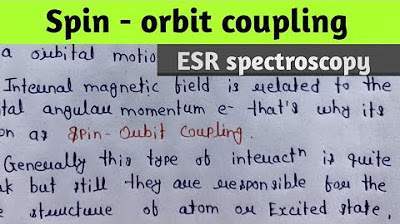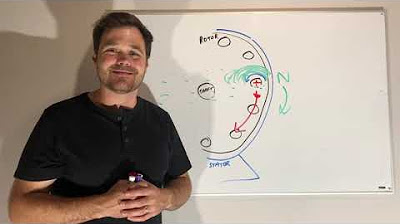Example 7.8 Introduction to Electrodynamics Griffith
Summary
TLDRIn this video, the speaker explains the concept of angular momentum and torque in the context of a magnetic field. The system consists of a loop with a magnetic field inside and an outer ring free to rotate. As the magnetic field changes over time, the electric field and force on the loop are analyzed. The speaker demonstrates how these changes lead to torque, and discusses the relationship between torque and angular momentum. The process is broken down step by step, emphasizing that angular momentum is independent of time but dependent on other factors like the magnetic field’s strength and duration of change.
Takeaways
- 😀 The example describes a system with two loops: one inside (with an orbital field) and one outside, which is a rotating ring.
- 😀 Faraday's Law of Induction is used to derive the electric field generated by the changing magnetic flux.
- 😀 The formula for the electric field is: E = - (a^2 / 2b) * (dB/dt), where 'a' is the radius of the inside loop, 'b' is the radius of the outer ring, and 'dB/dt' is the rate of change of the magnetic field.
- 😀 The force acting on the loop is proportional to the linear charge density (λ) and the electric field.
- 😀 The force on the ring is calculated using the expression F = λ * (2πb) * E.
- 😀 The torque on the ring is determined by multiplying the force by the radius of the ring (b), resulting in the formula: τ = - (a^2 * b * λ / 2) * (dB/dt).
- 😀 The torque leads to angular momentum, which is calculated by integrating the torque over time.
- 😀 The final angular momentum expression is: L = - a^2 * b * λ * π * b.
- 😀 The angular momentum does not depend on time, meaning it remains constant regardless of how quickly the magnetic field is turned off.
- 😀 This system shows that the angular momentum is independent of the time it takes for the magnetic field to be turned off, whether it's fast (milliseconds) or slow (gradual decrease).
Q & A
What is the main difference between Example 7.7 and Example 7.8 in the script?
-In Example 7.8, the setup includes a loop with a magnetic field in the inside loop, while the outside loop is just a free rotating ring. This is different from Example 7.7, though the concepts are related.
What formula is used to find the electric field in the script?
-The electric field is derived using Faraday's law, represented as E = -dΦ/dt, where Φ is the magnetic flux. The flux is calculated as the integral of the magnetic field B over the area (A), leading to E = -A²/(2B) * (dB/dt).
What is the significance of the magnetic field turning off in this scenario?
-The magnetic field initially does not depend on time. However, once the magnetic field is turned off, it changes over time, which leads to a change in the magnetic flux, inducing an electric field and a change in the system's behavior.
How is the force on the loop calculated?
-The force on the loop is calculated as F = qE, where q is the charge, given by the linear charge density λ times the circumference (2πr), and E is the induced electric field. The force is then used to compute the torque on the loop.
What is the expression for torque in this context?
-Torque (τ) is calculated as τ = rF, where r is the radius of the loop and F is the force acting on the loop. The force is proportional to λ, 2πb, the electric field, and the radius.
What happens to the angular momentum when the magnetic field is turned off?
-When the magnetic field is turned off, the angular momentum of the system is calculated, and the result shows that the angular momentum does not depend on time, meaning it remains the same regardless of how quickly the magnetic field is turned off.
How is the angular momentum derived from the torque?
-Angular momentum is derived by integrating the torque with respect to time. The torque expression contains the magnetic field change (dB/dt), and after simplifying, the angular momentum turns out to be proportional to a combination of factors like A², λ, and b, but it does not depend on time.
What does the term 'b₀' refer to in the final calculation of angular momentum?
-'b₀' refers to the initial value of the magnetic field before it is turned off. The final angular momentum is calculated based on this initial magnetic field value and does not depend on the time it takes for the magnetic field to go to zero.
What is the role of the radius in the torque and angular momentum calculations?
-The radius is essential in both torque and angular momentum calculations. It determines the moment arm in the torque equation and also plays a role in the final expression for angular momentum, as it's part of the force applied to the loop.
What can we conclude about the time dependency of the angular momentum from the script?
-The angular momentum does not depend on the duration of the magnetic field's change. Whether the magnetic field is turned off quickly or gradually, the resulting angular momentum remains the same, as time cancels out in the final expression.
Outlines

This section is available to paid users only. Please upgrade to access this part.
Upgrade NowMindmap

This section is available to paid users only. Please upgrade to access this part.
Upgrade NowKeywords

This section is available to paid users only. Please upgrade to access this part.
Upgrade NowHighlights

This section is available to paid users only. Please upgrade to access this part.
Upgrade NowTranscripts

This section is available to paid users only. Please upgrade to access this part.
Upgrade NowBrowse More Related Video

Spin-orbit coupling|| Spin-orbit intraction ||fine structure of - H atom|| #spin orbit coupling...

Angular Momentum of Particles Introduction

Gyroscopic Precession and Gyroscopes

Wheel Conservation of Angular Momentum Demonstration and Solution

How a motor rotor generates torque with magnetic fields

What Is Angular Momentum?
5.0 / 5 (0 votes)